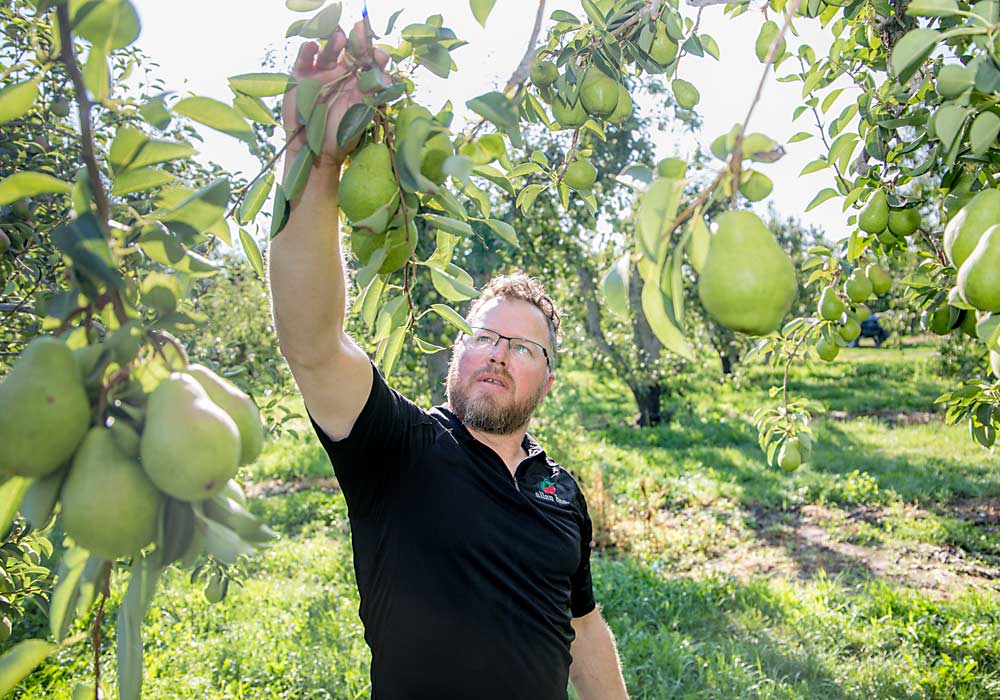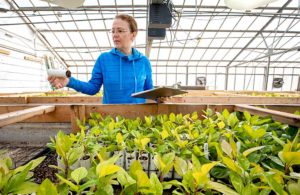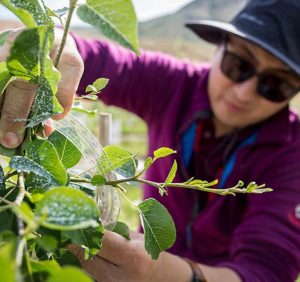
Proponents of diversifying the Northwest pear industry’s variety portfolio are now searching for more efficient alternatives to starting a breeding program from scratch, such as running trials on existing selections from other regions.
Early this year, the industry debated a proposal to use Washington Tree Fruit Research Commission reserves to fund the startup costs of a pear breeding program in Wenatchee, but officials asked for more information and options before committing.
Running trials on existing selections to find ones that fit the Northwest’s needs might yield quicker results and build momentum toward greater investment in the future, said Phil Doornink, a Wapato grower and a vocal supporter of pursuing a breeding program.
“We’re so late to the game already,” Doornink said.
Doornink and Rob Blakey, manager of research and development for Stemilt Growers in Wenatchee, are steering a fact-finding mission. The tentative timeline: Submit a proposal to the pear research subcommittee when the group meets to set priorities in October. That group would then take a formal vote at the next research review in February 2021 to advise the broader fresh and processed pear committees, which collectively represent Washington and Oregon pear growers under a federal marketing order.
The grower-assessment-supported fresh and processed committees contract with the Washington Tree Fruit Research Commission to manage scientific grants.
At the February 2020 pear research review in Yakima, Doornink and other proponents suggested using $650,000 of reserves to fund the first three years of a breeding program at the Washington State University Tree Fruit Research and Extension Center in Wenatchee. After that, Washington and Oregon growers would fund the program at $200,000 per year until it could pay for itself through the release of commercial varieties.
The WSU center already has a pear rootstock breeding program, looking for traits such as dwarfing, cold hardiness and disease resistance.
The industry leaders asked for alternatives to that proposal, at least to get started, said Tory Schmidt, a project manager for the research commission.
“It’s such a big decision,” Schmidt said.
Blakey breaks down the goals into short, medium and long range. Running trials on varieties already in the U.S. would be a short-term goal, he said. One place to look would be the U.S. Department of Agriculture National Clonal Germplasm Repository in Corvallis, Oregon. Even that short-game option would take seven to 10 years to reach a commercial crop, at best, he said.
Bringing in varieties from overseas breeding programs would be midrange. Building a sustainable breeding program, similar to WSU’s apple breeding program, would be long term — as in 30 years until it launches a viable commercial cultivar.
“We can’t wait 30 years,” Blakey said. “I’d worry there won’t be much of a pear industry around in 30 years if we don’t do something now.”
Work so far
So far, Blakey and Doornink, co-chairs of the newly formed Pear Variety Development Committee, and their colleagues have just scratched the surface of their search, building an administrative framework, prioritizing traits to pursue and establishing relationships with breeding programs throughout the world. Though a far cry from building a new breeding program, the cost of bringing in existing varieties will add up quickly in the form of travel, legal fees, trial costs and royalties.
The yearning for new varieties is not unanimous. Some growers would prefer to focus industry funds on more immediate problems, such as the costs of production for existing varieties.
Board members of Peshastin Hi-Up Growers in the Wenatchee Valley, for example, have reservations about spending grower money, when times are tight, on a breeding program they suspect may only benefit a few big players in the industry, not everyone.
“Why fund a new variety that we’ll have to replant, but they’ll plant it in the (Columbia Basin) and put us out of business?” said Kameron Miller, vice president of the co-op board, who farms in Cashmere and Dryden. When the apple industry made major investments in the new plantings in the Columbia Basin near Quincy and Ephrata decades ago, his dad saw the writing on the wall and took out apple blocks he knew could no longer compete. That’s not a future pear growers want to follow, he said.
Moreover, the pear industry has tried new varieties before, and it hasn’t panned out, Miller said.
“We already have a great variety,” said Hi-Up manager Ken Hemberry. If the industry can’t turn a profit producing Anjous from trees already in the ground, it’s hard to imagine growers will be able to afford gambling on a new one, he said. Instead, they want the industry funding to focus on better marketing and fruit quality, along with finding solutions to rising labor and pest control costs.
They’ve got a point, Blakey said, and the industry is working on those elements right now. But the industry also needs something new for the future.
“Yes, we need to work on stuff immediately but also fill the pipeline for the future,” Blakey said.
Some private companies already evaluate their own new pear selections, similar to the way they promote proprietary apples. However, the pear industry has a history of collaboration that lends itself to approaching this challenge with a more collective and coordinated approach, to prevent market segmentation, Doornink said.
For one thing, shelf space for pears is more limited than apples, Doornink said. Meanwhile, pear growers typically have smaller acreage than apple growers and many of them only grow pears. They would have trouble affording the upfront investment and the risk of developing new varieties on their own.
A search for new varieties is long overdue, he said. Already, at age 40, Doornink considers himself an advocate for the next generation of pear growers, not himself.
Meanwhile, he hopes the smaller, shorter-term goals might be an easier sell to the pear industry collectively, rather than an investment in a full-blown program, at least at first. He wants more buy-in.
“That’s how our industry succeeds: We’re all in this together,” he said. •
—by Ross Courtney








Leave A Comment